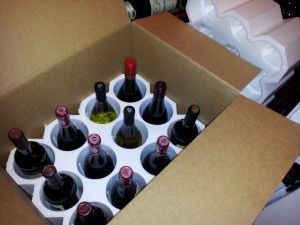How to move your wine collection
Often times people don’t think about how they’re going to move their wine collection until they find out that their movers either will not move the collection, or they realize that moving a wine collection along with their personal items is risky. A moving truck will often reach temperatures well above 100 degrees as there is no ventilation or air-conditioning inside a moving truck.
Below are some helpful things to consider when moving your wine collection. Click on the Request a Quote link and we will be happy to answer any questions you have.
1) Inventory Your Collection
Keep your own list of the bottles in your collection. You can download an Wine Inventory Sheet here to use if you do not have one. You can also use the web site CellarTracker to keep an online inventory of your collection.
2) Choose Boxes
There are four primary types of boxes. The box use depends on how you are transporting your collection.
 Styrofoam Shipper
Styrofoam Shipper
Used when shipping via overnight air delivery or cargo via commercial airlines. These boxes are durable and provide a small layer of insulation to protect the wine from temperature fluctuations (note they are not insulated, though). Their large size makes them less ideal for transporting on pallets in refrigerated trucks.
Double Wall
The preferred box for shipping in a refrigerated truck. The double walled construction and uniform size make these boxes ideal for transporting on pallets.
 Original Wood Crate (OWC)
Original Wood Crate (OWC)
Many top end wines come in wood crates. These crates are extremely durable and are fine for shipping in a refrigerated truck but cannot be used when shipping via overnight air delivery or air cargo.
Retail Boxes
Retail wine boxes are not designed to be used as shippers. They are typically single wall construction and become very weak quickly (they are designed to get wine from producer to retailer then discarded). We do not suggest shipping your wine in retail boxes as there is no consistent size and therefore once on a pallet, the boxes overlap with each other causing strain on the box which could lead to damaged bottles. In addition, retail boxes cannot be used to ship via overnight air delivery or air cargo.
3) Investigate Carriers
Not all carriers are qualified to transport wine. Your collection should be handled with the same care as any other refrigerated perishable food item. Shipping wine is unique though as the proper temperature for wine is 55 degrees whereas normal refrigerated food, such as milk and eggs, are transported at 40 degrees. Be sure the carrier you use treats your precious wine cargo with the utmost care and maintains 55 degrees and not 40 degrees.
A special note on using FedEx or UPS. Neither FedEx nor UPS will knowingly ship wine, unless you have a special license from them. Even if it is your own personal collection and you are shipping to and from your personal residence.
Click here for the UPS policy.
Click here for the FedEx policy.
4) Insurance Coverage
Determine the value of your collection and ask the carrier about providing insurance beyond the minimal liability coverage for your wine collection.
5) Check with your state
Some states have restrictions on the amount of alcohol you are allowed to bring into the state. Chances are you will not have a problem unless you are bringing hundreds of cases into a state. Click here for links to the various Alcohol Beverage Control (ABC) Boards.
FAQ’S on shipping your wine collection
Moving can be a stressful process, most moving companies do not transport wine since it is perishable and moving trucks can get intensely hot during transport. It is best to leave the transportation of your wine to a professional wine transportation company.
Q: Should I ship my wine in the summer?
A: We typically recommend against moving your collection during the summer months. If you must transport your wine during the hot summer months, be sure to only use temperature controlled door-to-door service.
Q: Will shipping my wine with the bottles upright dry out the corks?
A: Most wine transported from wineries is shipped upright. It takes months and months before the threat of a cork drying out and most transportation is done in weeks, not months. In addition, todays synthetic corks are resistant to drying out. The only time you should be concerned about corks drying out is if you have old, vintage wine. Any wine less than 10 years old should not be a problem.
Q: What is the benefit of using styrofoam shippers instead of cardboard?
A: Styrofoam shippers have two primary benefits: 1) insulation, and 2) rough handling protection. If your wine is to be transported by airplane, you should use styrofoam boxes as airplane transportation is typically the roughest method and does not provide full temperature control. The styrofoam will protect the wine against temperature fluctuations and rough handling. If transporting by truck, your wine will be shrink-wrapped on one or more pallets and will have full temperature control from door-to-door. For this reason, double-walled wine shipping boxes are the preferred box to use.
Q: Why shouldn’t I ship my wine with my furniture?
A: Whether you live in Arizona or Vermont, the back of a moving truck gets hot, very hot. Moving trucks are not temperature controlled so the temperature may fluctuate rapidly depending on the time of year. During the cool nights, the temperature inside the back of a truck could drop close to freezing and during the day, the hot sun could raise the temperature well above 100 degrees. These fluctuations in temperature are devastating to wine, especially older wine. Wine is also considered perishable and therefore many moving companies prohibit wine in their trucks.
Q: Why does it take longer for my wine to arrive than my furniture?
A: Unlike moving furniture, temperature controlled wine transportation is a small industry. In order for costs to remain as low as possible, wine transportation companies must fill each temperature controlled truck as much as possible. This means that your wine may sit in a temperature controlled wine storage facility until there is enough deliveries to warrant a full truck to travel to the town you are moving to. Having said that, trucking companies are also conscious about timely deliveries so even if there is not sufficient orders, your wine will still get transported in a timely manner.
Q: How do I ensure my wine is properly temperature controlled while in transit?
A: If transporting by truck, be sure the Bill-of-Lading clearly states that the load will be temperature controlled at 55 or 56 degrees. By stating this on the Bill-of-Lading, the Department of Transportation mandates the trucking company must abide. If transporting by air craft, be sure the company you use will take great care to ensure your wine is marked as perishable and requires special handling (the same as with meat and dairy). Airplane cargo areas are not temperature controlled but once in the air, the temperature naturally maintains a cool temperature. It is important that once the wine is offloaded from the airplane and placed in the warehouse with other refrigerated cargo. Note that not all commercial cargo areas have refrigerated storage areas so you will need to have your wine picked up immediately after the plane lands (or be sure the wine is held in an air-conditioned area of the warehouse).
Q: I only have a few bottles, can I pack them in my suitcase and take them on the plane?
A: Now that you cannot take bottles with you aboard commercial flights, many people pack wine in their suitcases that get checked as luggage. This is fine provided the wine does not break or leak. There are specially designed cases for transporting wine as luggage and we suggest you use these.
Q: Can I overnight my wine using FedEx or UPS?
A: Neither FedEx or UPS will accept wine shipments from private parties. They will only accept wine shipments from preapproved commercial companies with the proper licensing. Even if you decide to overnight your wine, remember that shipments are not temperature controlled and there is a chance your wine will sit in a hot truck or tarmac for longer than you’d like. If you overnight your wine, be sure to pack them in insulated styrofoam shipper approved boxes and select AM delivery.
Click here to see wine shipping policies for UPS.
Click here to see wine shipping policies for FedEx.
